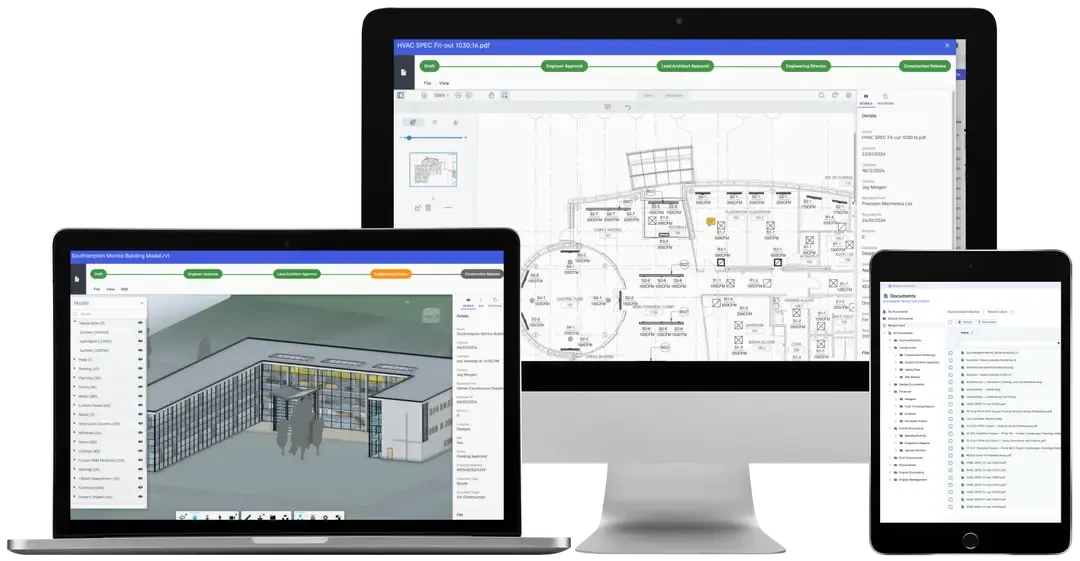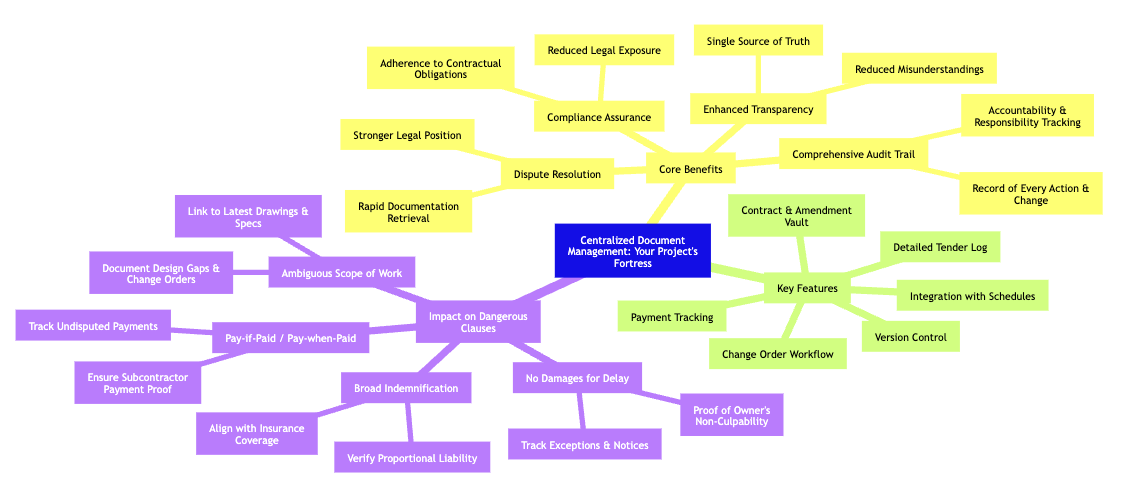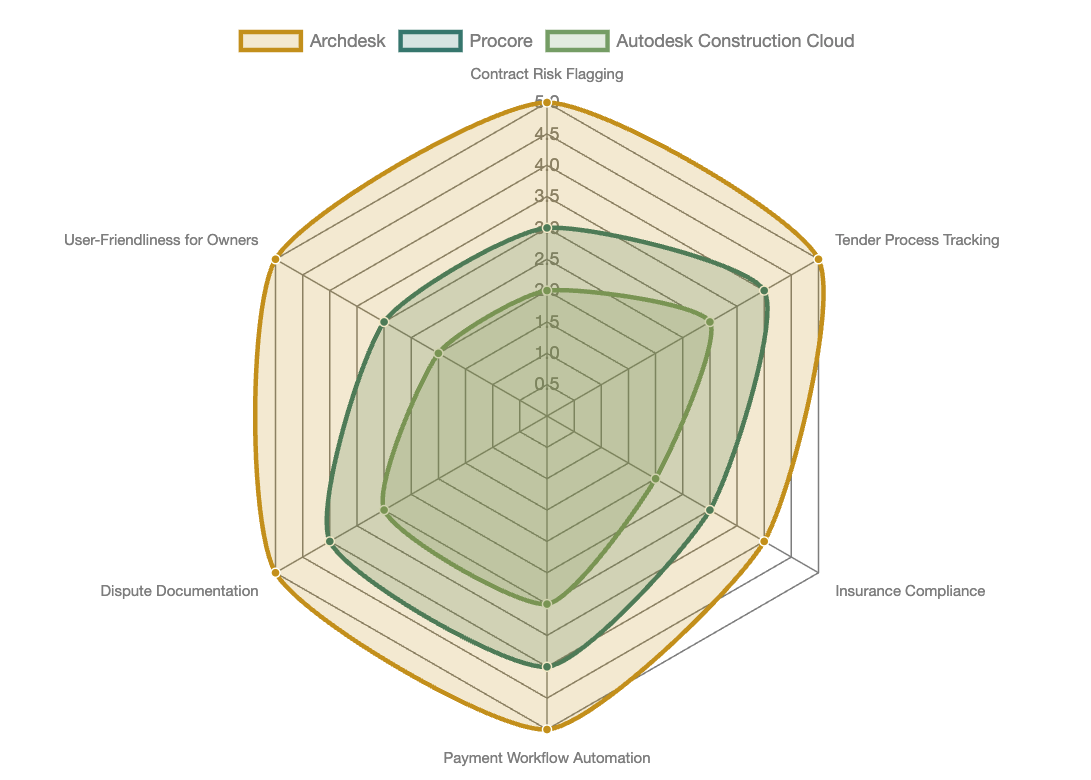Key Takeaways for Savvy Owners
- Redlining is Essential: Actively review and modify dangerous clauses before signing a contract to protect your interests and finances.
- Centralized Document Management is Your Superpower: Using a dedicated software platform to store and track all project data is your best defense against disputes and ensures compliance.
- Know the "Killer Clauses": Understand "no damages for delay," broad indemnification, and ambiguous payment terms to proactively negotiate better contract language.
Construction contracts are the backbone of any project, but they often contain hidden traps. As an owner, you might think you're just signing papers to get things moving, but sneaky clauses can cost you big time. We're talking delays that eat up your budget, fights over payments, or even lawsuits. This guide walks you through the worst offenders, showing you what to look for, how to fix them, and why solid document management is your best friend.
Think of it like this: A well-built structure needs a strong foundation. A successful project needs a well-crafted contract. But not all foundations are equal, and some contracts are designed to shift risk to you, the owner. Our goal here is to equip you with the knowledge to identify those weak spots and reinforce them.

Collaborative review of construction plans is crucial for identifying potential issues.
The Art of Redlining: Your First Line of Defense
What is Redlining and Why Does it Matter?
Before we dive into the dangerous clauses, let's talk about "redlining." No, it's not about drawing all over the document in red crayon (though it used to be!). Redlining is the process of marking up a contract with proposed changes and revisions. It's a key part of contract negotiation. Think of it as a conversation on paper, where you and the other party propose edits until you reach an agreement.
Historically, this meant physical markups with a red pen. Nowadays, we're all digital. Most people use "track changes" in Microsoft Word or Google Docs. You can also redline a PDF. The point is, redlining ensures everyone is on the same page about proposed changes, which helps prevent miscommunication. AI tools can even help with redlining, making the process faster and more accurate, but a human review is still essential, especially for key negotiation points.

Redlining involves making digital annotations and suggestions within a document.
Redlining Etiquette: Playing Nice (and Smart)
Redlining is a negotiation. So, it's important to approach it with some etiquette to keep things moving smoothly. Think of it like a polite debate, not a shouting match.
- Be clear and concise: When proposing changes, make sure they are easy to understand.
- Provide rationale: Explain why you are proposing a change. This helps the other party understand your perspective.
- Focus on the big picture: Don't get bogged down in tiny, insignificant details. Keep the overall goals of the contract in mind.
- Avoid over-redlining: Making too many unnecessary changes can overwhelm the other party and slow things down.
- Maintain a constructive tone: Keep communication open and respectful. Remember, you're trying to reach an agreement, not win an argument.
The Most Dangerous Clauses: What to Watch For
Alright, let's get down to business. Here are some of the clauses that can really mess with your project and your wallet if you're not careful:
1. No Damages for Delay (NDD) Clauses: The Time Trap
Imagine this: your project is delayed, and it's not your fault. Maybe the contractor hit unexpected site conditions, or a material delivery is held up. You're losing money every day the project isn't finished. Then you look at your contract, and boom! A "no damages for delay" clause.
What it says
"Contractor’s sole remedy for delay, disruption, acceleration or interference shall be an extension of time. Contractor waives any monetary claim."
Why it’s Dangerous
These clauses are designed to protect the owner from paying monetary damages to the contractor for project delays, even if the owner caused the delay. It basically says the contractor's only solution for delays is a time extension, not cash. Courts generally uphold NDD clauses, meaning they're often enforceable. However, there are exceptions. If the delay is caused by the owner's bad faith, active interference, willful misconduct, gross negligence, or if the delay is of an unreasonable length, the clause might not hold up.
For example, if you, as the owner, constantly change project drawings, fail to follow change order procedures, or provide faulty materials, an NDD clause might be thrown out. Imagine your general contractor locks up all workstations due to a paperwork error. Their mistake, but this clause means you foot the bill for extended timelines.
Owner's Redline Review & Mitigation
- Demand exceptions: Add exceptions for delays caused by the owner, third parties, or force majeure events (e.g., pandemics, natural disasters).
- Specify allowable delays: Limit the clause to 30 days unless extended in writing.
- Track delays meticulously: Even with an NDD clause, you still need to manage the project effectively. Any actions that contribute to unreasonable delays can weaken the clause's protection.
- Consider a time extension: If delays are unavoidable and not due to your fault, a time extension can be a fair solution.
Real-World Example: A contractor in Chicago once hit radioactive soil. Without a differing site conditions clause, they ate the cost. Lesson: Force majeure isn’t just for asteroids.

2. Broad Indemnification Clauses: The Blame Game
Indemnification clauses are like a game of "hot potato," but with legal liability. Everyone wants to pass it to someone else.
What it says
"Contractor shall defend, indemnify, and hold harmless Owner from any and all claims, damages, liabilities, including those caused in whole or in part by Owner."
Why it’s Risky
While you want the contractor to indemnify you, a broadly worded indemnification clause can backfire. If it's too broad, you might be accepting liability for things that aren't your fault or that your insurance doesn't cover. For example, an overly broad clause could make you responsible for the contractor's negligence. If a subcontractor’s crane drops on a worker, a broad indemnity clause could make you liable—even if you weren’t involved.
Owner's Redline Review & Mitigation
- Limit the scope: Limit indemnity to third-party claims (not your own employees). Require proportional liability, such as "Indemnification applies only to the extent the claim arises from your acts or omissions.”
- Align with insurance: Make sure the indemnification language aligns with what your general liability insurance covers. You don't want to agree to something your insurer won't pay for.
- Mutual indemnification: Consider asking for mutual indemnification, where both parties agree to indemnify each other for their respective negligence.
- Legal counsel: Always get legal advice on indemnity clauses. State laws often restrict these provisions.
3. Ambiguous Pay-if-Paid or Pay-When-Paid Clauses: The Payment Puzzle
"Pay-if-paid" and "pay-when-paid" clauses are like trying to solve a puzzle where some pieces are missing. They deal with when and if subcontractors get paid.
What it is
These clauses make a contractor's payment to a subcontractor dependent on the owner paying the contractor first.
- "Pay-if-paid": If the owner doesn't pay the general contractor, the general contractor doesn't have to pay the subcontractor. This shifts a huge amount of risk to the subcontractor.
- "Pay-when-paid": This usually means the general contractor will pay the subcontractor after they receive payment from the owner, but it doesn't excuse payment if the owner never pays. It's more about timing.
Why it’s Dangerous for Owners (Indirectly)
While these clauses might seem to protect you by making the general contractor responsible for subcontractor payments, they can lead to headaches. If subcontractors aren't paid, they can cause project delays, quality issues, or even file mechanic's liens against your property, which can tie up your project and cost you more in legal fees down the line. Plus, in many states, "pay-if-paid" clauses are not enforceable because they go against the state's interest in protecting construction participants from non-payment. Owners often misuse these clauses to stretch payment terms. But if a contractor goes bankrupt, you’re left funding the project yourself—even if you’ve already paid them.
Owner's Redline Review & Mitigation
- Negotiate "pay-if-paid" to "pay-when-paid": The latter ties payments to reasonable timelines, not the contractor’s cash flow.
- Demand a certification requirement: Insist on proof that the contractor has invoiced the owner (you) before delaying payments.
- Understand state laws: Be aware that the enforceability of "pay-if-paid" clauses varies by state. Many states have laws that disallow them.
- Prioritize fair payment terms: A project runs smoother when all parties are paid on time. Consider avoiding or negotiating these clauses to ensure your subcontractors are paid promptly, reducing the risk of disputes and liens.
4. Hidden "Waiver of Consequential Damages"
These clauses seem benign but block recovery for indirect costs like lost profits, rental extensions, or business disruption.
A Closer Look
A hotel developer might waive consequential damages only to realize they can’t claim compensation if a delayed project misses a profitable season. While owners want liquidated damages from the GC for late delivery, GCs often slip in caps on their liability and delete caps on yours.
How to Fight Back
- Carve out exceptions: For willful misconduct or breaches of critical timelines.
- Track soft costs: In real-time. This can prove consequential damage exists.
- Healthy compromise: For liquidated damages, use a fixed dollar per day, equaling projected rent loss, with an aggregate cap (5–10 % of contract value). Make consequential damages a mutual waiver, except for liquidated damages expressly stated. Tie the liquidated damages start date to substantial completion, not punch-list sign-off.
5. Liquidated Damages that Act Like a Penalty: The Overly Punitive Clause
Nobody likes delays, and liquidated damages clauses are meant to compensate you if the project isn't finished on time. But sometimes they go too far.
What it is
Liquidated damages clauses set a pre-determined sum that the contractor must pay you for each day the project is delayed beyond the agreed-upon completion date.
Why it’s Dangerous for Owners
While you want to be compensated for delays, if the liquidated damages are set too high and don't represent a reasonable estimate of your actual losses, a court might view them as a "penalty" and refuse to enforce them. This means you could end up with no compensation for the delay at all.
Owner's Redline Review & Mitigation
- Reasonable estimate: Ensure the liquidated damages amount is a reasonable pre-estimate of the actual damages you would incur if the project is delayed (e.g., lost rent, increased financing costs, overhead).
- Document your losses: Be prepared to show how you calculated the liquidated damages amount if challenged.
- Don't make it a penalty: The goal is to compensate for losses, not to punish the contractor.
6. Congressionally Broad "Dispute Resolution" Clauses
Contracts that force disputes into inconvenient jurisdictions or expensive arbitration are a trap.
Why It Matters
A contractor might prefer arbitration in their home state, forcing you to travel and pay legal fees in their backyard.
Mitigation Steps
- Specify neutral venues: For example, your project’s location or a major city.
- Demand mutual Escalation Clauses: Mandate mediation before arbitration, reducing blow-up costs.
7. Changes in Site Conditions: The Unexpected Discovery
Construction sites can be full of surprises. You might dig and find ancient ruins, a giant rock, or unexpected groundwater.
What it is
This clause addresses what happens if unforeseen physical conditions are encountered at the site that are different from what was expected.
Why it’s Dangerous for Owners
If this clause isn't well-drafted, you, as the owner, could bear the full cost and time impact of these unexpected discoveries. If the contract doesn't clearly define responsibilities and compensation for changed conditions, it can lead to disputes and cost overruns.
Owner's Redline Review & Mitigation
- Clear definition: Ensure the clause clearly defines what constitutes a "changed condition" and how it will be handled.
- Notification procedures: The contractor should be required to notify you immediately upon encountering a changed condition, giving you time to assess and decide.
- Equitable adjustment: The clause should allow for an "equitable adjustment" to the contract price or time if a changed condition impacts the project. This means a fair increase or decrease based on the impact.
- Site investigation requirement: Include a clause requiring the contractor to investigate the site thoroughly before bidding. This puts some responsibility on them to identify obvious issues.
8. Termination for Convenience: The Owner's Trump Card (with a catch)
Sometimes, you just need to walk away from a project, even if the contractor hasn't done anything wrong. That's where termination for convenience comes in.
What it is
A termination for convenience clause allows the owner to end the contract at any time, for any reason, even if the contractor is not in default.
Why it’s Dangerous for Owners
While this sounds like a great deal for you, it usually comes with a cost. You'll typically have to pay the contractor for work completed, plus demobilization costs, and sometimes even a reasonable profit on the uncompleted work. If the clause isn't clear on these costs, you could face disputes and unexpected expenses.
Owner's Redline Review & Mitigation
- Clear compensation terms: Ensure the clause clearly outlines what compensation the contractor will receive if you terminate for convenience. This should include payment for work performed, demobilization costs, and potentially a reasonable profit on the terminated portion of the work.
- Notice period: Specify a reasonable notice period for termination.
- Negotiate a settlement: Try to negotiate a termination settlement into the contract that pre-determines overhead and profit for uncompleted work.
9. Flow-Down Clauses: The Subcontractor Chain Reaction
Flow-down clauses are like a legal ripple effect, passing obligations down the line.
What it is
A flow-down clause makes subcontractors and material suppliers subject to the same terms and conditions as the prime contract between you (the owner) and the general contractor.
Why it’s Dangerous for Owners (Indirectly)
While seemingly efficient, if the prime contract contains unfair or overly risky clauses, the flow-down clause will push that risk down to the subcontractors. This can lead to financially unstable subcontractors, disputes, and potential liens against your property if they feel unfairly treated or unpaid.
Owner's Redline Review & Mitigation
- Review all subcontracts: Ensure the prime contract terms are reasonable before they are flowed down. Encourage your general contractor to use fair subcontracts.
- Understand subcontractor risks: Recognize that overly burdensome flow-down clauses can harm the financial stability of subcontractors, which can ultimately impact your project.
10. Warranty and Maintenance Clauses: The Post-Completion Headache
The project is done, the ribbon is cut, but your responsibility isn't over. Warranties and maintenance clauses are crucial for long-term protection.
What it is
These clauses guarantee that the work will be free of defects and function according to specifications for a certain period after completion.
Why it’s Dangerous for Owners
If these clauses are weak, ambiguous, or non-existent, you could be left with expensive repairs for defects that emerge after the project is finished. Sometimes, "warranty" and "maintenance" are used interchangeably, but it's important for the contract to define them clearly.
Owner's Redline Review & Mitigation
- Clear definitions: Define what constitutes a defect, the warranty period, and the contractor's responsibilities for correcting defects.
- Maintenance responsibilities: If the contract includes ongoing maintenance, clearly outline who is responsible for what.
- Performance bonds: Consider requiring performance bonds, which guarantee the contractor will complete the work and fix defects, providing an extra layer of financial protection.
11. No-Lien Clauses and Lien Subordination: The Financial Straitjacket
Mechanic's liens can be a real headache for owners, allowing unpaid contractors or suppliers to place a claim on your property.
What it is
A "no-lien clause" attempts to prevent contractors or subcontractors from filing a mechanic's lien. "Lien subordination clauses" typically give lenders' claims priority over mechanics' liens.
Why it’s Dangerous for Owners
While a no-lien clause might seem appealing, many states prohibit or severely limit their enforceability, as they aim to protect construction participants from non-payment. If such a clause is included and later found unenforceable, you could still face liens. Lien subordination clauses can also impact the ability of contractors and subcontractors to get paid, again leading to disputes.
Owner's Redline Review & Mitigation
- Understand state lien laws: Lien laws are complex and vary greatly by state. Consult legal counsel to understand your state's specific regulations regarding no-lien clauses and lien waivers.
- Conditional lien waivers: Ensure you are getting proper lien waivers from all parties (contractor, subcontractors, suppliers) as payments are made. Conditional waivers are typically preferred, where the waiver becomes effective only upon actual payment.
12. Ambiguous Scope of Work: The "What Exactly Are We Building?" Problem
This is perhaps the most fundamental clause, and its ambiguity can be disastrous.
What it is
The scope of work (SOW) defines everything the project must cover, from equipment to material unit prices and subcontractors. It should also reference relevant plans, specifications, and design drawings.
Why it’s Dangerous for Owners
If the SOW is vague or incomplete, it's an open invitation for disputes, change orders, and cost overruns. The contractor might claim certain work wasn't in their scope, leading to additional charges. If design is 70 % when bid, this clause turns every missing detail into a freebie.
Owner's Redline Review & Mitigation
- Extreme detail: Provide as much detail as possible in the SOW. Specify every task, material, and standard of quality.
- Reference documents: Explicitly reference all plans, specifications, drawings, and other design documents.
- "Reasonably Inferable" trap: Be cautious of clauses that allow the contractor to perform work that is "reasonably inferable" from the plans. While this sounds good, it can lead to disputes about what was truly inferable versus an extra. Thoroughly review design documents for completeness.
- Clear deliverables: Define clear deliverables and milestones.
- List known design gaps: In an exhibit.
- Require written change orders: For any deviation > $5k or impacting schedule.
Your Redline Game Plan: A Practical Guide
Now that we've covered the clauses, let's get into how to review and fix them. Redlining is like editing a design file—mark up the changes, track versions, and keep notes.
Step 1: Gather Your Documents
Use a tool like Archdesk to centralize everything in one spot. No more digging through emails or folders; it's all there, searchable. Remember to compare your Request for Proposal (RFP) addenda list to Contract Exhibit A. This ensures consistency and prevents hidden changes.
Step 2: Spot the Risks
Go through the contract line by line. Make a list: "This clause here—too broad. Change it to this." Use a risk allocation audit to map who bears risk for differing site conditions, weather, or force majeure.
Step 3: Fix and Track
Redline in a shared document, then use software to log changes. Archdesk lets you add comments and approvals, so everyone's on the same page. You should also cross-check insurance: confirm Builder’s Risk Insurance (BAR) is required and that you’re named as an additional insured. Validate that indemnity clauses don’t conflict with Commercial General Liability (CGL) policies.

Effective collaboration in construction document reviews ensures everyone is on the same page.
How Centralizing Data Saves Your Project
Meticulous document management isn't just busywork—it's your defense when clauses get invoked. Centralizing data in a platform like Archdesk gives the owner a significant advantage.
The Power of Centralized Data
Centralizing your project data means having one single source of truth for everything related to your construction project. This includes:
- Contracts and Amendments: All versions of your contracts, including every redlined draft and signed amendment, are stored in one accessible place.
- Change Orders: Every change order, from initiation to approval and execution, is tracked and linked to the relevant contract.
- Communication Logs: Emails, meeting minutes, phone calls, and any other communication are logged and easily searchable.
- Drawings and Specifications: The latest versions of all project drawings and specifications are readily available.
- Financial Documents: Invoices, payment applications, and payment records are all linked to the project.
- Daily Logs and Progress Reports: Records of daily activities, site conditions, and work progress are consistently updated.
How does this help with dangerous clauses?
- Dispute Resolution: When a dispute arises over a "no damages for delay" clause or an ambiguous scope of work, you have all the documentation at your fingertips. You can quickly pull up communication, daily logs, and previous contract versions to prove your case. This makes litigation less likely or, if unavoidable, significantly strengthens your position.
- Compliance: Keeping all records organized ensures you comply with contractual notice requirements, payment terms, and other obligations.
- Transparency: A centralized system promotes transparency among all project stakeholders, reducing misunderstandings.
- Audit Trail: Every action, every change, every communication is recorded, creating an undeniable audit trail. This is your best friend when proving what happened, when, and who was responsible.

A mindmap illustrating the core benefits and features of centralized document management in mitigating contract risks.
Detailed Tender Process Tracking
The tender process is where many contract terms are initially shaped. Tracking this process meticulously is another layer of defense.
- Bid Management: Software can help you organize and compare bids from multiple subcontractors. This isn't just about price; it's about understanding what each bid includes and excludes.
- Pre-contract Communication: All communication during the tender phase, including clarifications, questions, and answers, should be logged. This helps clarify the intent behind contract clauses and can be crucial if disputes arise later.
- Scope Alignment: Ensure that the scope of work proposed in the winning bid perfectly aligns with the contract you eventually sign. Any discrepancies should be resolved before signing.
Ensuring Compliance and Reducing Risks
A robust construction management software isn't just about storing documents; it's about actively managing your project to stay compliant and reduce risks.
- Automated Alerts: Many systems can set up automated alerts for important dates, like payment deadlines, notice periods for delays, or warranty expirations.
- Workflow Automation: Automating workflows for change orders, approvals, and document revisions ensures that processes are followed consistently, reducing human error.
- Version Control: This is a big one! Imagine you have five versions of a contract, and someone is working off an old one. Version control ensures everyone is always working with the latest, approved document.
- Security: Storing sensitive contract information requires top-notch security. Cloud-based platforms offer secure document storage and access controls.
How Software Solutions Stack Up for Owners
Choosing the right construction management software is a big decision for owners. Many options exist, each with its strengths. Here's a look at how different platforms generally compare in key areas relevant to contract risk mitigation and overall project management from an owner's perspective.

This radar chart compares different construction management software platforms based on their perceived effectiveness in key areas relevant to owners for contract risk mitigation. Scores are on a scale of 1 to 5, with 5 being the highest, reflecting an opinionated analysis of their capabilities from an owner's perspective.
The radar chart above gives a visual comparison. Archdesk is designed with owners in mind, providing strong features for risk flagging, tender tracking, and payment workflows, which directly address common contract pitfalls. Procore and Autodesk Construction Cloud are strong contenders, especially in broader project management and BIM integration, but may require more setup or customization for owner-specific contract risk management. The key is finding a system that seamlessly integrates all these aspects, so you're not juggling multiple platforms.
Frequently Asked Questions
What does "redlining" a contract mean?
Redlining a contract means marking up the document with proposed changes, revisions, or comments. It's a key part of contract negotiation, allowing parties to suggest edits until an agreement is reached. In modern practice, this is typically done using digital tools with "track changes" features.
Why are "no damages for delay" clauses dangerous for owners?
These clauses limit the contractor's remedy for project delays to only a time extension, preventing them from claiming monetary compensation, even if the owner or a third party caused the delay. This can leave the owner responsible for significant indirect costs, such as lost revenue or increased financing, without recourse.
How can I protect myself from broad indemnification clauses?
You can protect yourself by limiting the scope of indemnification to only cover issues directly caused by the contractor's negligence or actions. Ensure the language aligns with your insurance coverage, and consider negotiating for mutual indemnification where both parties agree to cover their respective liabilities.
What is the difference between "pay-if-paid" and "pay-when-paid" clauses?
"Pay-if-paid" clauses make a contractor's payment to a subcontractor contingent on the contractor first receiving payment from the owner. If the owner doesn't pay, the contractor isn't obligated to pay the sub. "Pay-when-paid" clauses, on the other hand, establish a timeframe for payment to the subcontractor after the contractor receives payment from the owner, but they don't excuse payment if the owner never pays. "Pay-when-paid" is generally preferred by owners and subcontractors as it provides more certainty.
Why is centralized document management important for contract risk mitigation?
Centralized document management provides a single source of truth for all project-related documents, including contracts, changes, communications, and financial records. This enables quick retrieval of information for dispute resolution, ensures compliance with contractual obligations, promotes transparency, and creates an audit trail that can be vital in legal proceedings or negotiations.
Conclusion
Construction contracts are complex, but they don't have to be terrifying. By understanding the most dangerous clauses and adopting meticulous document management practices, you can turn your contract into a strong fortress, protecting your project and your financial well-being. Remember, a good contract is a living document, and its effectiveness depends on how well you manage it throughout the project lifecycle. Investing in the right software and a proactive approach to contract review and management is not an expense; it's an investment in your peace of mind and the success of your projects. Don't be that owner who realizes too late that a tiny clause in the contract has unleashed a monster. Be smart, be prepared, and build with confidence!
References
What Is a No Damages Delay Clause in Construction Contracts? - long-intl.com
Identifying Potential Risks in Construction Contract Language - Galloway Law Firm





